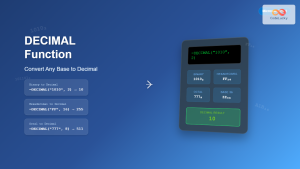In the realm of programming, representing numbers in different bases is a fundamental concept. While decimal (base-10) is the most common representation for humans, computers often work with binary (base-2) or hexadecimal (base-16). Python's built-in hex() function allows you to effortlessly convert integers into their hexadecimal string equivalents.
Understanding Hexadecimal Representation
Before diving into the hex() function, let's briefly understand the hexadecimal system. It uses 16 unique symbols: 0-9 and A-F, where A represents 10, B represents 11, and so on until F representing 15. Each hexadecimal digit represents a power of 16.
For example, the decimal number 255 is represented as FF in hexadecimal, which is (15 16^1) + (15 16^0).
The hex() Function: Syntax and Parameters
The hex() function is incredibly straightforward. It accepts a single argument, an integer, and returns its hexadecimal representation as a string prefixed with "0x".
hex(integer)
Parameters:
- integer: The integer you want to convert to hexadecimal.
Return Value:
- A string representing the hexadecimal equivalent of the input integer, prefixed with "0x".
Code Examples
Let's illustrate the hex() function with some practical examples:
Basic Conversion
>>> hex(10)
'0xa'
>>> hex(255)
'0xff'
Handling Negative Integers
The hex() function seamlessly handles negative integers, returning their two's complement hexadecimal representation.
>>> hex(-1)
'-0x1'
>>> hex(-10)
'-0xa'
Converting Large Integers
>>> hex(1000000)
'0x989680'
>>> hex(0x1000000)
'0x1000000'
Common Use Cases
The hex() function is commonly used in scenarios involving:
-
Low-level programming: When working with memory addresses, registers, or binary data, hexadecimal representation often provides a more concise and readable format compared to binary.
-
Color representation: In web development and graphics programming, colors are frequently represented using hexadecimal values (e.g., #FF0000 for red).
-
Hashing algorithms: Some hashing algorithms produce hexadecimal output, and the
hex()function can be used to convert the resulting integers into their string representation.
Potential Pitfalls
While the hex() function is generally straightforward, it's essential to remember a few points:
-
Type mismatch: The
hex()function only accepts integers as input. Attempting to pass a float or string will result in aTypeError. -
Limited precision: For floating-point numbers,
hex()is not suitable, as it only represents the integer part.
Performance Considerations
The hex() function is highly optimized and executes quickly. Its performance is generally negligible compared to other operations in your code.
Conclusion
The hex() function is a valuable tool for Python developers, allowing for efficient conversion between integers and their hexadecimal representations. By understanding its usage and potential pitfalls, you can effectively employ this function in various coding scenarios. Whether you're delving into low-level programming, working with color representations, or handling hashing algorithms, the hex() function provides a convenient way to work with hexadecimal values.




